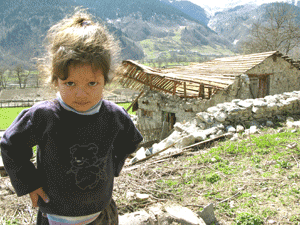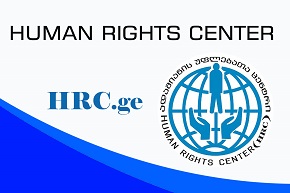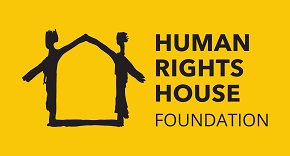 Tea Topuria
Tea Topuria
The Parents can not let their children sleep at home in Mestia as the threat of a landslide is a constant threat. Spring is traditionally the season of natural disasters in Georgia. The government has not conducted preventive activities against landslides and floods for several years now. The consequence is that people die and houses, bridges, roads are damaged. At the background of tensed political and social situation environmental problems appear to be far less important in Georgia. It is for this reason that government needs to start thinking about floods and landslides ahead of time and not only when the water level is dramatically rising. It would be better if the government would spend more on prevention rather than having to spend money and limited resources after the damage has been done.
When the children in Mestia, Svaneti region see clouded sky they run out of their houses as if the ground is shaking with an earthquake. The reason for their fear is simple: the soil moves in Mestia as if it is alive. There is a big threat that even a light rain will cause a killer land slide. The cracks on the houses in Mestia are so large that one can look through them. There are several century old Svanetian castles that are completely ruined.
The ground floor of the Niagurians’ house is flooded with the coming of each spring and the family has to wade in rubber boots. The water on the ground floor reaches half meter. The rooms where the family children used to sleep in are now half under water. In Mtvarisa Merlani’s house water leaked directly from the walls. Seven people live in this house as they have no other place to live. They can only take their children away from the danger and the adults can stay at night with relatives.
Zhenia Kvanchiani, Doli village, Becho Board of Administration: The half of the families has escaped from the village. The houses are ruined. 20 families are left from 45. These 20 are not safe in their own houses; we sleep at nights with a neighbor whose house is somewhat less destroyed and less dangerous. The children will remain in the neighboring village until this dangerous period is behind. So now you will not be able to hear a child’s voice in Doli.”
Tamar Kvitsiani, Doli village, Becho Board of Administration: “When the rain starts in our village all the inhabitants take up hoes and spades and try to return the swollen river to its normal place by digging out land so that the water has enough space in its own bed. We do all we can to keep the village from flooding. The road has to be reconstructed after every rain. We do it with our own labor with the use of oxen. We do not have any kind of technical equipment for this activity. There are clefts at the top of the village. They fill up with water after rain and when it happens the land starts sliding and brings trees along with the slips. There is another threat of landslide from anther end of the village where the Jesus Christ’s (Pusdali in Svanetian language) Church is located. The slide that might come from there will destroy directly our houses.”
Nugzar Niguriani, a Mestia inhabitant says that the landslides and floods are now more frequent, especially since 1987 when they started mining rocks for road construction material. The underground water springs were damaged as well. As a result geologists declared this place to be a red zone. Twenty years have passed since then, many governments have changed but nobody wants to show any interest to this zone and for the people who just happened to be living in this zone.
There is a possibility of artificially cleaning this territory from water. However, nobody is involved individually in carrying out such work. The only thing that might be done to reduce the threat is evacuate people from the danger zone as environmental refugees. However, this option is only under consideration. People say that there are no free lands left in Svaneti where to resettle people, and besides that – it will be much more expensive for the state to organize this resettlement. And if the evacuation would really takes place, this place will lose its several historical villages with their characteristic flora and fauna, not to mention the culture of its people.
When the landslides occur much noise is made and people are able to evacuate in time. However, it is not the case for livestock. This is not the same for flood, as time is short there are often flashfloods. People might not be able to leave their houses in time in the face of such danger. After every heavy rain people are either left without a house or without a cow or two, and often animals are the only source of family income. The fact is more dramatic when you know that the soil is not good enough in Svaneti to sustain agriculture. The situation is especially bad for people as there are also no jobs in the region.
The Project Proposals Lost in the Way
According to the data provided by the Ministry of Environmental Protection and Natural Resources a total of 205 extraordinary situations were registered in Georgia in 2007, and these were caused by natural disaster: 3 people died, 416 injured and 260 hectares of agricultural land were flooded. In 2005, about 190 places where people are living were placed under the high risk classification zone in terms of natural disaster risks. 9,610 hectares of agricultural land became useless. Specialists inspected approximately 5,000 houses for damage. Of this number, 3,000 were damaged, which was the result of various kinds of natural disasters.
All regions of Georgia were harmed by natural disasters in one form or another, especially the coastal and mountainous regions. The catastrophes happen every year, and this has been the case for the last few years: Svaneti, Samegrelo, Adjara, Guri – landslides and floods have destroyed bridges, roads, electro-transmission posts. Natela Gujejiani, a Mestia inhabitant says her house can not be reached with either a car or a tractor. Her plight is not the exception.
Giorgi Mebonia, the head of Tsalenjikha Board of Administration (Samegrelo region): “The River Enguri washes away the crops in the village of Lia. The water released from the electic station reservoir spills over several meter over the long river bank and locals who live nearby have to leave temporary their houses until the water recedes. The distance between villages Jvari and Chkvauri, situated on opposite sides of the Enguri increases, with the passing of years. Soon there will be no road connecting these villages.”
The head of the Tsalenjikha board associates these processes with the mass deforestation. He thinks that the natural disasters are largely association with the lost of forest cover. The Mestians saw what brought the cutting down of forests to them. Now they are afraid even to collect woods not to say anything about cutting trees down.” It is very dangerous to take even one log from the forest,” says Gocha Khorguani.
Despite this kind of situation, the state apportioned only 2, 235 Million GEL for 2008 to the Center of Monitoring and Prognosis, which is responsible for monitoring, foreseeing and prevention of dangerous natural processes in Georgia. The Caucasus Environmental NGO Network (CENN) states that this amount of money is meager. About 50,000 erosive washes are registered within Georgia, and out of which 10 000 are active landslides. The money apportioned to the Center is hardly enough, and is not even adequate to partly study the dangerous natural processes that must be faced
There are other problems as well. Nana Janashia, the CENN executive director states that the central and local governments must communicate more actively with one another. There are several incidents that back up her statement. Take for example when flood damaged Adjara, Irakli Goradze, deputy head of the government of Adjara told journalists that the regional government would not donate to the preventive activities to protect against flooding in Adjara, and this was delayed until the central government would send them related data to consider. In response to this statement, the central government said that they had already sent all necessary information and there must be some misunderstanding.
Irakli Goradze: “We can allocate money from the local budget only when we know what it will be spent on. Research of this field depends upon the central government’s prerogative, as it is not the Adjarian government’s responsibility. If we have a project proposal from the subsequent central governmental body, we will then be able to finance it from the local government. There are some environmental problems that are very easy to solve. However, before anything can be done, it is first necessary that the problem be well-researched. That’s what complicates the overall situation.”
Meanwhile, the Ministry of Environmental Protection and Natural Resources states that project proposals have been distributed to the regional bodies and it is left to them how to freely spend the allocated funding for the maximum public good.
The lack of communications caused that the Ministry of Environmental Protection and Natural Resources did not take into consideration funding needs for Mestia in 2008 national budget. The state allocated half a million GEL for the purpose of taking immediate measures, and this was only as a result of CENN informing them about the situation facing Svaneti. This money is the guarantee that the disasters will be avoided in many parts of Mestia for the next 10 years.
But the general problem will not be solved by treating the problems in several places of Mestia. Nobody thought ahead about the prevention of natural disasters after the collapse of the USSR. Every dyke and bridge in Georgia must be now renovated. Forests must be regenerated. There are many territories that must be studied. Meanwhile, the flood season has come.
Overall, there is much work that remains to be completed and forethought must be made as to how best to spend budget money. Experts understand that the resources are not adequate to cover all requirements. Nonetheless, those living Svaneti are now used to such neglect – they understand that when all is said and done, they can rely only on the mountains that surround them and themselves. “The most important that disaster does not state at night,” say Mestia’s residents.



